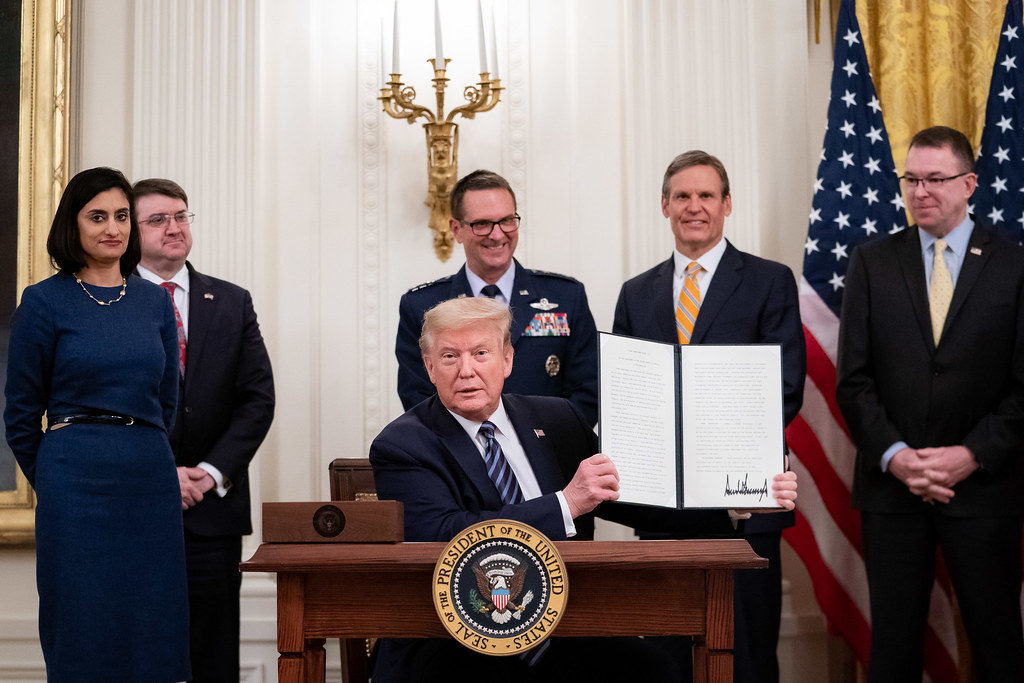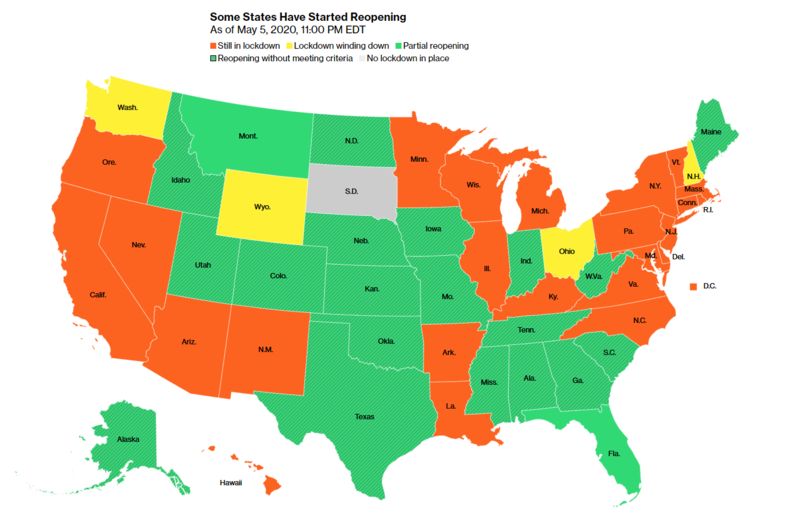Thinking about flying? Here’s what you need to know now - Morning Call
Thinking about flying? Here’s what you need to know now - Morning Call |
- Thinking about flying? Here’s what you need to know now - Morning Call
- New CDC-led Genomics Consortium That Harnessed Genetic Sequencing to Track the SARS-CoV-2 Coronavirus includes Clinical Laboratories and IVD Firms - DARKDaily.com - Laboratory News
- Trump Pushing to Open Economy Soon - Outside The Beltway - Mobile Edition
| Thinking about flying? Here’s what you need to know now - Morning Call Posted: 28 May 2020 08:49 AM PDT  On Friday, the Transportation Security Administration screened 348,673 people at American airports, the most since travel went into a free-fall in mid-March, likely driven by people traveling ahead of Memorial Day weekend. Still, a year ago, more than 2.7 million people were screened, showing just how far the industry has to come back. |
| Posted: 11 May 2020 12:00 AM PDT Medical laboratories are already using gene sequencing as part of a global effort to identify new variants of the coronavirus and their genetic ancestors Thanks to advances in genetic sequencing technology that enable medical laboratories to sequence organisms faster, more accurately, and at lower cost than ever before, clinical pathology laboratories worldwide are using that capability to analyze the SARS-CoV-2 coronavirus and identify variants as they emerge in different parts of the world. The US Centers for Disease Control and Prevention (CDC) now plans to harness the power of gene sequencing through a new consortium called SPHERES (SARS-CoV-2 Sequencing for Public Health Emergency Response, Epidemiology, and Surveillance) to "coordinate SARS-CoV-2 sequencing across the United States," states a CDC news release. The consortium is led by the CDC's Advanced Molecular Detection (AMD) program and "aims to generate information about the virus that will strengthen COVID-19 mitigation strategies." The consortium is comprised of 11 federal agencies, 20 academic institutions, state public health laboratories in 21 states, nine non-profit research organizations, and 14 lab and IVD companies, including:
'Fundamentally Changing How Public Health Responds' Gene sequencing and related technologies have "fundamentally changed how public health responds in terms of surveillance and outbreak response," said Duncan MacCannell, PhD, Chief Science Officer for the CDC's Office of Advanced Molecular Detection (OAMD), in an April 30 New York Times (NYT) article, which stated that the CDC SPHERES program "will help trace patterns of transmission, investigate outbreaks, and map how the virus is evolving, which can affect a cure." The CDC says that rapid DNA sequencing of SARS-CoV-2 will help monitor significant changes in the virus, support contact tracing efforts, provide information for developers of diagnostics and therapies, and "advance public health research in the areas of transmission dynamics, host response, and evolution of the virus." The sequencing laboratories in the consortium have agreed to "release their information into the public domain quickly and in a standard way," the NYT reported, adding that the project includes standards for what types of information medical laboratories should submit, including, "where and when a sample was taken," and other critical details.  Sharing Data Between Sequencing Laboratories and Biotech Companies The CDC announced the SPHERES initiative on April 30, although it launched in early April, the NYT reported. According to the CDC, SPHERES' objectives include:
Implications for Developing a Vaccine As the virus continues to mutate and evolve, one question is whether a vaccine developed for one variant will work on others. However, several experts told The Washington Post that the SARS-CoV-2 coronavirus is relatively stable compared to viruses that cause seasonal flu (influenza). "At this point, the mutation rate of the virus would suggest that the vaccine developed for SARS-CoV-2 would be a single vaccine, rather than a new vaccine every year like the flu vaccine," Peter Thielen, a molecular biologist at the Johns Hopkins University Applied Physics Laboratory, told the Washington Post. Nor, he said, is one variant likely to cause worse clinical outcomes than others. "So far, we don't have any evidence linking a specific virus [strain] to any disease severity score. Right now, disease severity is much more likely to be driven by other factors." That point was echoed by Anthony Fauci, MD, Director of the National Institute of Allergy and Infectious Diseases, in a March 22 interview with CBS News. "I have no doubt it's mutating as all RNA viruses mutate," he said. However, he added, "we have not seen thus far any type of change in the way it's acting." Fast improvements in gene sequencing technology have made it faster, more accurate, and cheaper to sequence. Thus, as the COVID-19 outbreak happened, there were many clinical laboratories around the world with the equipment, the staff, and the expertise to sequence the novel coronavirus and watch it mutate from generation to generation and from region to region around the globe. This capability has never been available in outbreaks prior to the current SARS-CoV-2 outbreak. —Stephen Beale Related Information: Genome Canada Leads $40 Million Genomics Initiative to Address COVID-19 Pandemic COVID-19 Genomics UK Bad News Wrapped in Protein: Inside the Coronavirus Genome How Coronavirus Mutates and Spreads Covid-19 Arrived in Seattle. Where It Went from There Stunned the Scientists 8 Strains of the Coronavirus Are Circling the Globe. Here's What Clues They're Giving Scientists SARS-CoV-2 Genomes Let Researchers Retrace Viral Spread, Mitigation Effects Varied COVID-19 Strains Not a Problem for Vaccines—For Now The Coronavirus Mutates More Slowly Than the Flu, Which Means a Vaccine Will Likely Be Effective Long-Term Response to "On the Origin and Continuing Evolution of SARS-CoV-2" |
| Trump Pushing to Open Economy Soon - Outside The Beltway - Mobile Edition Posted: 06 May 2020 06:54 AM PDT "Will some people be affected badly? Yes." Governors around the country are starting to lift stay-at-home orders in order to re-open the economy. The President is cheering them on while acknowledging that more Americans will die as a result. Bloomberg ("Trump Pivots to 'Phase Two,' Risking More Death to Save Economy")
The map of this is rather stark:  While I'm still in lockdown, as are those in the surrounding states, huge swaths of the country are wide open. Let's pretend for the sake of discussion that we had a normal President who made rational calculations after weighing evidence from experts and who had basic human empathy. He would certainly refrain from talking in this manner. And, one imagines, he would be using the bully pulpit to persuade governors and citizens to approach this more judiciously, slowly opening the economy in sectors and areas of the country where it made the most sense rather than simply based on the mood of the governor. We would likely avoid, for example, the bizarre spectacle of Bristol, where the Virginia side of town is still on lockdown and the Tennessee side is wide open. Aside from the vagaries of federalism, there's no rational basis for that kind of thing: either both sides of town should be open or both should be closed. Still, as Sean Trende wrote over the weekend, the rationale for the lockdown has steadily shifted and the current version is unsustainable for the long haul.
While we're still not testing at adequate levels, we've otherwise achieved those objectives. Trende lays out quite a bit of data in that regard before observing,
But, for good reason in my view, the goalposts have moved.
Those are worthy goals, indeed. Trende shares them, as do I. But he's right that this wasn't the going-in position.
While Trende doesn't say it, the reason for this is obvious: when the status quo was "open for business," governors were under pressure to issue lockdown orders to bend the curve. But, now that the lockdowns are the status quo, governors are under different pressure. On the one hand, lots of people want their life and livelihood back and are clamoring for a re-opening. On the other, almost by definition, more people will get sick and die as a result. And, quite understandably, they don't want to be blamed for that. I don't have a firm view on when, whether, and where to open back up. I don't have enough information to make even a semi-informed guess and am frankly not sure the experts really know enough, either. But I agree with Trende's larger point: that we make these sorts of cost-benefit analyses all the time. To avoid the rabbit holes of comparisons with the flu, driving, or other dangerous but more common practices, let's just stick with COVID-19. We've decided that it's too risky to allow bars and movie theaters—recreational activities where social distancing is next to impossible—to stay open but have declared grocery stores, home improvement stores, delivery services, and a whole host of other commercial activities to be "essential." We're quite literally accepting a much higher degree of risk for those in "essential" industries and their households. And, indeed, workers in those sectors—and, of course, the medical professions—are dying at much higher rates. Trende closes with the politics of the thing:
While there are a myriad of explanations for this, including both different information sources and very different lived experiences (the virus is hitting major metropolitan areas very much harder than it is rural areas, at least thus far) one imagines it would be a lot less severe with a normal President. Then again, maybe not. The lockdowns might be generating even more resentment if they were perceived as coming at the behest of Hillary Clinton. It's also worth noting that those of us in the pundit class are bearing a much smaller share of the sacrifice. Most of us can continue our work from the comfort of reasonably nice homes, secure in our paychecks and health coverage, while waiting for Amazon drivers to bring us whatever we need. Again, I don't claim to have a solution here. The infection and death rate in the DC metropolitan area, where I live, are too high to reopen. The governor shut down the schools for the year back in March and extended stay-home orders through June 10 weeks ago. Clearly, we need to be able to adequately test people for infections as a bare minimum for getting back to anything like "normal." But I don't think it's reasonable to wait until we have a cure for the disease, either. It's quite possible we'll never have one. |
| You are subscribed to email updates from "nytwhat to cook this week" - Google News. To stop receiving these emails, you may unsubscribe now. | Email delivery powered by Google |
| Google, 1600 Amphitheatre Parkway, Mountain View, CA 94043, United States | |



Comments
Post a Comment